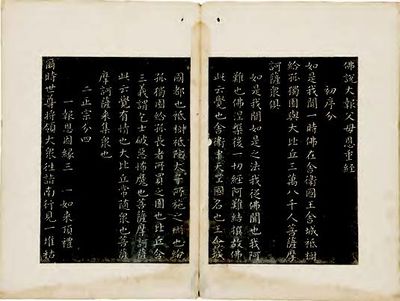Early Printing in Korea - 3.3 Other Early Printing
| Understanding Korea Series No.2 | ||
| ← Previous | Early Printing in Korea | Next → |
| 2) Movable Type Printing | 3) Other Early Printing | 4. The Invention and Development of Metal Movable Type Printing |
(1) Takinbon(拓印本, Reprography)
Takbon is also called tapbon (榻本, rubbed print) or tabon (打本, dabbed print). It is the process of making prints out of inscriptions or pictures engraved on rocks or metal surfaces, by applying ink on a wet paper using an ink-soaked cotton dabber and avoiding the engraved area. When takbon is bound like a book, it is called takinbon and appears in several different types: scroll (卷子形), folded (折帖) and thread-bound (線裝).
The most common type of takinbon in Korea are the writings on stele (石碑文), and plenty of folded type books are extant. These examples precede the Goryeo period, and early epigraphs suffering from minimum wear and tear are of special historical importance.
(2) Seokinbon(石印本, Lithography) and Other Type of Prints
Seokinbon is the most primal form of lithography: a flat surface printing method that uses a completely smooth limestone plate for printing, relying on materials’ hydrophobic and hydrophilic qualities. It was invented by a German named Alois Senefelder but has been replaced by zinc, aluminum and plastic plates. As photographic technology advanced, it evolved into photolithography and offset lithography.
In Korea, seokinbon was adapted towards the end of the 19th century and in the beginning was mainly used to print stamps, post cards and product labels by the Ministry of Agriculture, Commerce and Manufacturing. There are several seokinbon preserved from the initial period: Daegabeopcheop (大家法帖, Collected Works of Great Calligraphers) published in 1908 by Gwangdeokseogwan (廣德書館, Gwangdeok Library), Munjayujip (文字類輯, the Collection of Various Chinese Idioms) published in 1913 by the Singuseorim (Singu Books), Hunmongjaheo (訓蒙字會, Chinese Character Textbook for Children) published in the same year by Sinmungwan, the Amita Sutra published in 1914 by Munadang (文雅堂), and Sinsikchogandok (新式草簡牘, the New Learning Book of Chinese Cursives) published in the same year by Bojinjae.
This method boomed during Japanese colonial rule, enjoying its heyday in the 1920s. Even after 1945, it was still used predominantly to print genealogy books, anthologies and documents. It almost disappeared completely after the 1970s.
The aforementioned printing technologies have been evolving with the speed of scientific advancement and development. Modern techniques include yuinbon (油印本, mimeography), tajainbon (打字印本, typeset printing), offset lithography, yuripan (琉璃版, collotype), zinc lithography, photolithography, yeonginbon (photo printing), and laser printing. Yuinbon is created by applying ink with a roller after using a stencil to scratch a greased, lined paper and placing it on a polygraph machine. This method was widely used until the 1970s as the most convenient way of printing.
Offset lithography is the most common form of printing technology, and more convenient and precise techniques are in development. Yeonginbon is a replica of a rare book or useful material from the past, published through either photo-printing or other scientific methods.
| Understanding Korea Series No.2 Early Printings in Korea |
|
1. Korea’s Memory of the World and Early Printing (古印刷) 2. The Origins of World Printing Culture and Korea · 2.1 The Emergence of Printing Culture and Korea · 2.2 The Development of Printing Materials 3. Woodblock Printing and Movable Type Printing · 3.1 Woodblock Printing · 3.2 Movable Type Printing · 3.3 Other Early Printing 4. The Invention and Development of Metal Movable Type Printing · 4.1 Metal Movable Type Casting · 4.2 Metal Movable Type Typesetting 5. The Publishing Entities of Korean Traditional Prints · 5.1 The Government Publications (官) · 5.2 The Private Publications |
